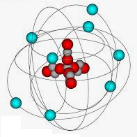Knowledge Graph
Quantum knowledge is ingested semi-automatically (see Ingest submenu) and integrated in the ontology-based quantum ontology. When the portal is launched, the knowledge graph will be globally accessible under the user login accounts on the QSO Portal. All quantum science and engineering, and stakeholders, can create accounts for access. The knowledge graph has many applications, some of which can be accessed via the QSO portal. Consider this scenario: a classical physics systems engineer somewhere on the globe is developing a product and needs a sensor for navigation. She queries the future Quantum Technology Pipeline, or submits a request for information (RFI) request that contains full requirements, to the Quantum Technology Pipeline (represented in knowledge graph with graph query engine). It yields no results. This is still valuable information: there are no classical counterparts for her current application. However, in some cases, there will be one or more quantum counterparts. With the push of a button she can get a high-fidelity comparison of matching quantum sensors, and all matching classical sensors. Because of the ontology-based knowledge graph, the results are a list of very detailed specs, metrics, IP rights (and more) terms are displayed in tabular form, in column A. To the right, the remaining columns display all the matching classical and quantum sensors, with percentage differences on performance. Within seconds the classical developer is fully aware of the potential quantum alternatives, their technical readiness levels, ranging from TR level 1 to level 9, and whatever other data that has been requested, assuming it has been ingested into the knowledge graph; if not, that cell of the table is empty. Missing data can be updated by the QSO Portal user(s), and the user can run the comparison again. Some will argue that this can be achieved in other ways, such as a relational database, but the knowledge graph approach here has many advantages, the first of which is complete integration of data rather than disjointed, relational tables, and it is ontology-based. Another is that the data can be viewed exactly how it resides in the knowledge graph, i.e., interactive. The user can use the Knowledge Graph page in the QSO Portal to navigate nodes via links between notes, or the user can drill down into the details in other ways.
